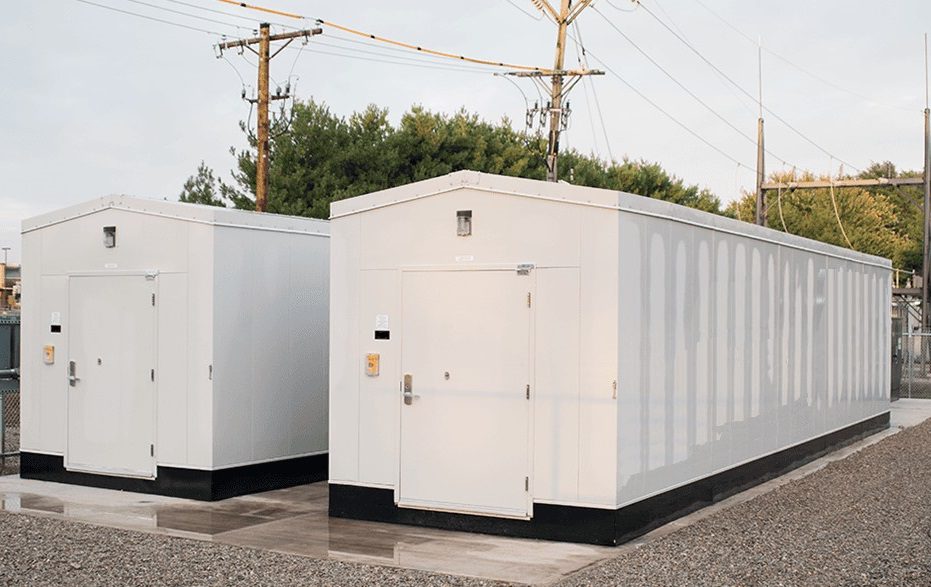Electricity powers our world. Energy demand continues to increase as we consume more electricity. The electric grid must be able to keep up. Grid-scale battery storage systems support the grid, offering more reliable access to electricity.
Using battery storage balances the grid’s energy reserves. Large-scale energy storage efforts improve our ability to deliver a consistent flow of energy, even during outages. Energy storage systems also open the door for more off-grid power options.
Read more about grid support and long-term energy storage.
What Is a Battery Energy Storage System?
First, let’s talk about what a grid-scale battery is. Battery energy storage systems (BESS) rely on multiple batteries to gather energy for later use.
BESS can include lithium-ion batteries, lead-acid batteries, flow batteries or flywheels. Lithium-ion batteries are the most popular in global and national markets. Operators can install grid-scale batteries in transmission or distribution networks.
Why Add Grid-Scale Battery Storage?
Battery storage improves grid reliability and increases the value of clean energy, like solar and wind power. When resources produce less power, operators can send power from batteries to the grid. Excess energy is stored for the future.
Since batteries store energy, utility companies can provide uninterrupted service at non-peak power generation times or during high demand when there’s more stress on the grid.
Interest in grid-scale batteries is growing for many reasons. A few of the top motivators include:
- Rapidly increasing energy demand
- Interest in off-grid energy options
- Need for stable power in outages and brownouts

1. An Increasing Demand for Energy
As lifestyles and communities change, our demand for continuous power grows. Populations, commercial growth and weather contribute to higher energy demand.
Energy demand has increased by an average growth rate of 2.4% from 2015 to 2019. World electricity demand rose by almost 2% in 2022, according to the International Energy Agency’s (IEA) Electricity Market Report 2023.
Aging Infrastructure
Can we meet demand and have reliable distribution? On America’s 2021 Infrastructure Report Card from the American Society of Civil Engineers, energy infrastructure earned a “C-.”
People currently receive electricity from about 600,000 miles of transmission lines and 5.5 million miles of local distribution lines. Of all service outages, 92% come from distribution segments.
Weather-related events, equipment failure and other problems affect dependability. Many of the electric grid’s components are aging. About 70% of the country’s transmission and distribution lines are in the second half of their expected lifespans.
Interest in Electric Vehicles
A growing interest in electric cars also affects energy demand. As electric vehicles hit the road, more charging stations with Electric Vehicle Supply Equipment (EVSE) ports will be added across communities.
Charging stations connect to the grid. Pulling more power from the grid increases the overall load. EV charging stations need reliable access to electricity so consumers can drive their vehicles.
Adding to the Energy Mix
Grid-scale batteries store and distribute energy while adding to our total energy capacity. These energy storage systems play a significant role as the United States invests in wind and solar.
Since solar and wind produce intermittently, energy storage systems balance the energy flow. Batteries store excess energy during non-peak times. Then, they send that energy into the grid when demand is high. Long-term energy storage systems make these resources more dependable and valuable for our country’s energy mix.
2. Increase Off-Grid Options
Off-grid electric options are becoming more popular as the cost of energy increases. If you are off-grid, you are not connected to a utility company.
In remote areas, accessing the electric grid can be difficult. Deploying battery energy storage systems can be less expensive than extending power lines. Investing in off-grid options is easier than ever, whether you desire energy independence or your location is a factor.
Using a stand-alone system that generates, stores and distributes power eliminates your reliance on the grid and sidesteps grid-related outages others may experience.
3. Stabilize Power in Crises
Continuous access to power is a necessity. Energy demand, weather, equipment failure and car crashes can cause outages. Reliability is a challenge for transmission and distribution systems. Consumers need electricity even when harsh weather strikes or the load drops.
Weather Events
The Texas power grid froze when severe storms hit in 2021. Most Texan power plants use natural gas to produce electricity. Yet, electricity is also needed to generate natural gas. Freezing temperatures and power outages affected this loop. The event shut down both natural gas and electricity production.
When bad weather hits, battery storage systems serve as grid support, providing energy on hand.
Brownouts
When AC power voltages lower, it isn’t good for electronics. High demand, strain or disruptions on the electric grid can result in brownouts. Low voltages can damage electronic equipment.
Sometimes, utility companies cause brownouts as an emergency measure to prevent the system from failing completely. Battery energy storage systems help avoid the causes of brownouts by providing more power during high demand.
Blackouts
Failing equipment or weather can cause blackouts in a service area. Complete loss of power is never a good thing—unless it’s planned. Utility companies may plan rolling blackouts to take the stress off the system’s load.
In these cases, battery storage can help ease the load or provide back-up power when systems are down. If the system fails, the battery can discharge energy until everything is back up.
Grid-Scale Battery Growth
The U.S. Energy Information Administration (EIA) predicts battery storage in the United States will increase by 2025. Grid-scale battery storage installations quadrupled in the first quarter of 2022, with California and Texas leading the charge.
In October 2022, 7.8 GW of utility-scale battery storage was in operation in the United States. More battery installations are planned.
Custom Energy Storage Components
Energy is a necessity. Storage batteries are one way to ensure there’s enough electricity available to power homes and businesses at any time.
As the need for large-scale energy storage grows, production for energy storage components will increase. If you’re an energy storage manufacturer, you need numerous components for the systems you produce.
Work with a metal fabrication company you can trust. At Metaltech in Lebanon, MO, we design, fabricate and assemble custom parts.
Request a quote online to get started! You can also give us a call at 417-426-5577. We have over 20 years of experience in custom OEM part fabrication. You can rely on us for your grid-scale energy storage components.




